ORDER
Psittaciform.es
FAMILY
Psittacidae
GENUS & SPECIES
KEY FEATURES
• This rare, majestic blue bird is the longest of all parrots
• Does not reach breeding maturity until the age of 10 years
• Prefers to lay its eggs in the holes of dead palm tree stumps
• Tremendously strong beak is mainly used to crack open nuts — but is capable of tearing apart a wrought-iron cage
WHERE IN THE WORLD?
Found mainly in jungles and forests in central South America; through interior northeastern Brazil and extending into eastern Bolivia? and northern Paraguay
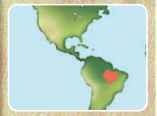
Lifecycle
Hyacinth macaw pairs form a close bond that can last for life; though they both care for their chicks through early life, the survival rate is low, due to predators and climate.
HABITAT
The hyacinth macaw is found mainly in the inland tropical jungles, swamps, forests and palm groves of Brazil. The three main areas of distribution include Amazonia in Brazil; around the pantanal habitats of the upper Rio Paraguay basin extending into Bolivia; and through interior northeastern Brazil.
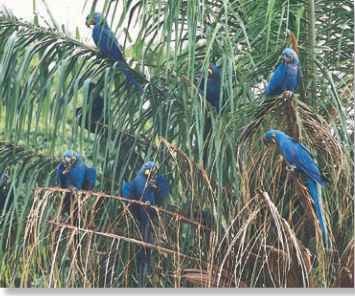
A Calm in the palm
A small flock of hyacinth macaws rests close to its abundant food source.
The two-toned tongue of the hyacinth macaw is black and yellow.
In addition to water, macaws drink fluid from unripe palm fruits.
The hyacinth macaw rubs its two bill sections against each other; this not only sharpens them but also prevents excessive growth, which would impede feeding.
FOOD & FEEDING
The macaw eats a variety of fruits, nuts and seeds, but it favors the nuts of palm trees, using its strong bill to simultaneously crack a nut and mash the kernel. The fleshy tongue helps to keep large particles out of the throat. The macaw has discovered that rodents eat the outer layers from fallen nuts, but cannot manage to crack the kernels — the tasty portions the macaws prefer. The clever macaw cuts and drops fruits to the ground for the rodents, such as agoutis, then returns the following day to grab the dehusked kernels.
CONSERVATION
Considered rare and vulnerable, the hyacinth macaw has been on the IUCN (World Conservation Union) Red List in Bolivia, Brazil and Paraguay since 1994. With populations between 2,550-5,000, the hyacinth macaw is at risk of becoming extinct if humans continue to exploit its habitat. Illegal capture and hunting, as well as logging, agriculture and hydroelectric projects, are major threats to this bird’s survival and habitats.
Favorite food
A macaw can turn in all directions to reach a nut.
BREEDING
In the early phases of courtship, the male hyacinth macaw will perform a number of displays for the female, such as dipping his head, spreading out his tail and lowering his wings; he will also contract his pupils and offer her food. The female will reciprocate with similar exhibitions. Both members of the pair will peck and nibble each other gently as signs of affection. The female nests high in a hollow tree hole just large enough for her to fit through; this helps protect her eggs from predators and temperature changes. She lays 2-3 white eggs, which she alone incubates for 27-30 days.
Young chicks are sensitive to the outside elements and do not leave the parents’ care until about 1 2 weeks of age. It is rare for more than one youngster to be successfully reared to fledging because the chicks are especially susceptible to damp weather conditions and threats from poachers, who sell them for captive breeding. Juveniles reach maturity at 10 years of age.
Peck and preen A courting pair of hyacinth macaws affectionately nibble while cleaning hard-to-reach head feathers.
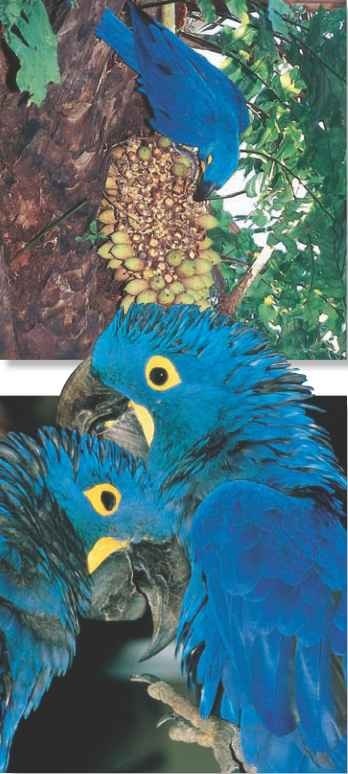
BEHAVIOR
Mostly sedentary, the hyacinth macaw circulates in small flocks or pairs into areas where food is available. Though capable of flying to great heights, the hyacinth macaw stays low, flapping its wings steadily. The small flocks will stay together during many night journeys, remaining active and quite visible on moonlit nights. In flight, the hyacinth macaw utters loud, repetitive cries and will draw from an extensive repertoire of sounds during courtship rituals, including trarrree-arree and kru calls. The sound of the bird’s harsh warning calls has often been compared to the growling and whimpering of a small dog.
BONDING TOGETHER
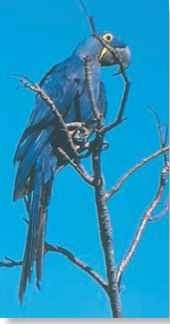
A Powerful fercher The macaw grasps a branch with its thick toes.
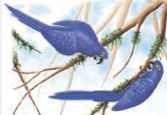
Showing off…
Two macaws perch on a dead branch; one hangs upside down as the other watches with interest.
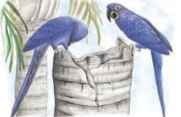
House hunting…
The breeding pair searches for the perfect home. A tree cavity will provide adequate protection.
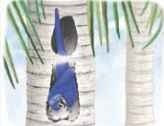
Room for one more…
After laying and rearranging her eggs, the female remains in the snug nest for about 30 days.
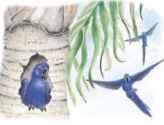
Caring parents
The adult birds steadfastly care for this one remaining chick, a survivor of damp weather and predators.
PROFILE
Hyacinth Macaw
With its powerful bill and brilliant blue coloring, the majestic macaw is a portrait of strength and beauty.

CREATURE COMPARISONS
The great green macaw (Ara ambigua) is slightly smaller than its blue counterpart, the hyacinth macaw.The green macaw has much in common with its relative: it is very rare; it has a large head and hooked beak; and it favors nuts and seeds. The green macaw’s plumage is mostly olive-green with a contrasting red and blue tail. Both species lay 2-3 eggs and prefer to travel in small family units or pairs. The great green macaw is found only in the Atlantic lowland of Central America in Costa Rica and in northern Colombia, generally farther north and west than the hyacinth macaw.
| VITAL STATISTICS | |
| Weight | 3-4 lbs. |
| Length | Up to 40″, including a 24″ tail |
| Sexual Maturity | 10 years |
| Breeding Season | December- . March |
| Number of Eggs | 2-3 |
| Incubation t Period | 27-30 days |
| Fledging Period | 100-110 days |
| Breeding Interval | 1 year |
| Typical Diet | Nuts, seeds, fruit |
| Lifespan | Unknown |
RELATED SPECIES
• The hyacinth macaw is 1 of 3 species in ‘ the genus Anodorhynchus; the others are the indigo macaw, A. leari, and the glaucous macaw, A. glaucus. All three species have striking blue plumage and reside in South America. There are 332 species in 78 genera of parrot in the Psittacidae family. Parrots join the cockatoos of the family Cacatuidae, in the order Psittaciformes.

